Teens are statistically one of the highest risk groups for drug abuse. Teens abusing drugs is a common situation because of peer pressure, newfound social freedom, new social situations, stress at home or in school, and curiosity. Statistics tell us that people are most likely to begin abusing drugs during their teenage years.
Table Of Contents:
- What Are The Dangers Of Teens Abusing Drugs?
- What Are The Facts About Teenage Drug Use?
- Which Substances Do They Usually Abuse?
- Is Vaping Common Among Teens?
- Why Do Teenagers Try Drugs?
- How Can Drugs Be Dangerous For Teens?
- What Are The Common Signs of Addiction?
- What Should One Do If They Think A Teenager Is Abusing Drugs?
- How Can Teen Substance Abuse Be Prevented?
- Are There Treatment Options For Teens?

By the time they are seniors, almost 70% of high school students will have tried alcohol, 50% will have taken an illegal drug, nearly 40% will have smoked a cigarette, and more than 20% will have used a prescription drug for a nonmedical purpose.
Overall, teen drug use seems to be declining compared to previous years. Still, we cannot become complacent because teens who do abuse illicit and prescription drugs remain at risk for addiction and overdose.
According to the National Survey on Drug Use and Health statistics, 333,526 people under 18 were treated for substance abuse or teenage alcoholism in 2020.
Over 1.5 million underage persons are introduced to drugs in the United States every year, corresponding to over 4,000 new drug users per day. Costs of emergency and non-emergency medical treatment reach billions in taxpayers’ money every year. It is easy for adolescents to access many kinds of drugs, and they are more likely to become addicted than adults because their brains aren’t fully formed. Sometimes, trying a particular drug just once is enough.
Teens Abusing Drugs: What Are the Dangers?
Even though teens using drugs is illegal, and teenagers are usually made aware of this fact by their parents and teachers at their school, adolescent substance abuse is still a significant problem. A survey by the National Institute on Drug Abuse found that in 2020, 46.6% of teens would have tried some form of illicit substance by the time they turn 12.
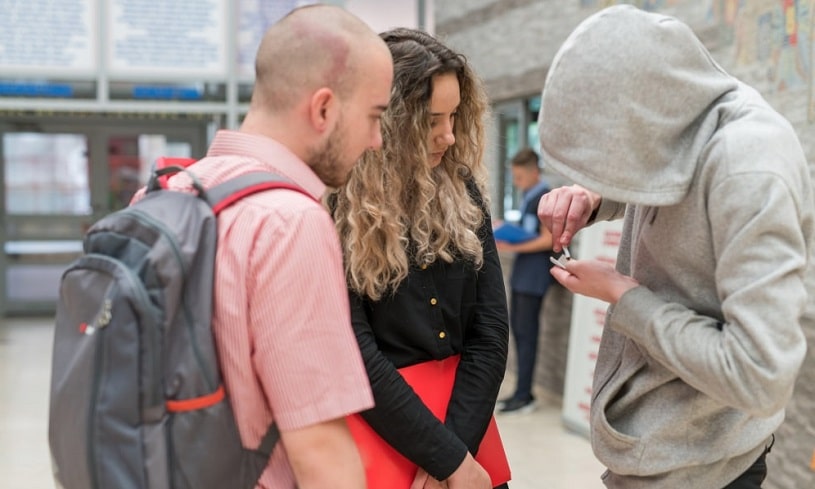
Drug use is dangerous for any person. However, it is even more hazardous for teenagers than adults. First of all, teenagers are more likely to experiment with substances without realizing or thinking about the consequences. It happens because their brain is not fully developed yet, and they may not be able to make rational decisions in terms of long-term outcomes. Moreover, they lack knowledge of the dangers adults are aware of. In addition to that, the effects drugs have on teens are more severe and can lead to more severe side effects.
Teens Abusing Drugs Expose Themselves to the Risk of Effects Such As:
- Injuries or accidents
- Getting arrested
- Having problems with concentration
- Poor academic performance
- Memory problems
- Changes in brain development
- Affected physical and mental growth
- Increased risk of mental health problems
- Overdose
- Death
Substance abuse can hinder brain development, and being under the influence leads to the inability to make rational decisions.
According to the National Institute on Drug Abuse statistics, in 2019 alone, 4,777 teens died because of a drug overdose in the US. The problem of teens abusing drugs is prevalent and is continuously growing. It is not something to be ignored.
Facts About Teens Using Drugs
The good news is that, according to the most recent statistics from the National Institute on Drug Abuse (NIDA), overall teen substance use is lower than in previous years, not higher.
The bad news is that the number of teens abusing drugs is still too high, especially concerning marijuana.
NIDA’s yearly report, the Monitoring the Future Survey, asked over 50,000 students in hundreds of schools around the country to self-report their substance use during the past month. And taken as a whole, many of the resulting figures are down from last year. On the other hand, 14.5% of the students surveyed reported having used marijuana during the previous month, and that’s the highest percentage of teens using drugs found in this survey since 2013.
What Percentage Of High School Students Use Drugs?
The following chart synopsizes this survey’s overall findings on teens abusing drugs:
Percentage of Teens Who Self-Reported Drug and Alcohol Use in 2020 (8th, 10th, and 12th grades combined)
| NAME OF DRUG | PAST-MONTH USE |
|---|---|
| Alcohol | 21.2% |
| Any Illicit Drug | 16.4% |
| Marijuana | 14.7% |
| Vaping Products | 21.4% |
| Cigarettes | 4.3% |
| Adderall | 3.3% |
| Hallucinogens | 1.4% |
| OxyContin | 1.4% |
| LSD | 1% |
| Heroin | 0.2% |
Remember, these are combined figures. They are even more interesting when breaking them down by individual grades because they point out that substance abuse is not limited to upper-graders, as many parents might hope.
For Example, Among Teens Abusing Drugs, the Breakdown Was:
| SCHOOL GRADES | PAST-MONTH USE |
|---|---|
| 8th Grade | 8.7% |
| 10th Grade | 18.2% |
| 12th Grade | 22.2% |
According to a separate survey conducted by the University of Michigan, more than 35% of 12th graders use marijuana, a higher rate than any other drug. The same is true of 8th graders. Teenage alcoholism and tobacco abuse in 8-12th graders continue to decline, but teens abusing drugs, even prescription medications are still at risk of addiction.
Where Do Teens Get All These Drugs?
There are a remarkable number of sources for illegal substances, many of them available to teenagers. For example, 60% of teens abusing drugs in recent studies report getting them at school. Some get them at home or from friends’ houses with similarly unsupervised medicine cabinets.
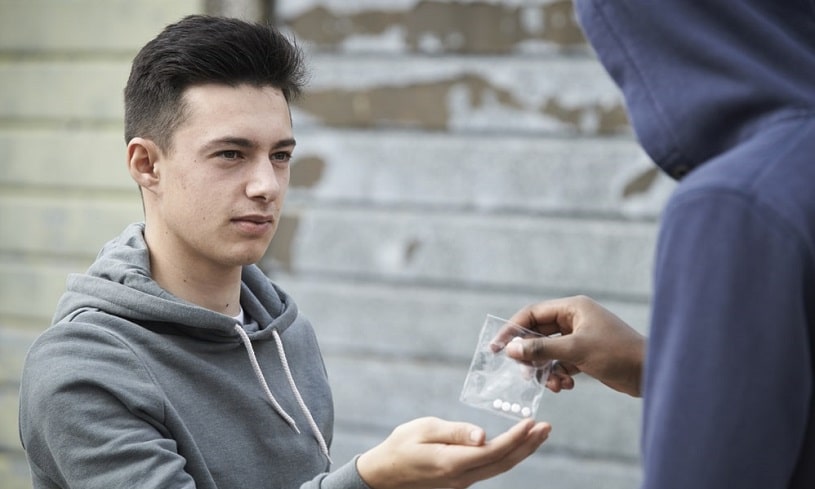
They can purchase over-the-counter medications such as cough medicines, diet pills, and non-opioid pain relievers at their nearest grocery store or pharmacy. And sadly, teens tend to know more about the Internet than their parents do, so they can often find access to drugs ranging from marijuana to fentanyl to heroin on the DarkNet.
Substances Commonly Abused By Teens
Teens are often more prone to experimenting than adults. In addition, they are frequently willing to try substances they know their friends are using, making dependency on marijuana, cocaine, heroin, alcohol, or another substance more likely to occur.
Alcohol
Since drinking alcohol is legal for adults and is considered socially acceptable, it downplays the risks associated with alcohol in the eyes of teens. They think that since they’ve seen “grown-ups’ drink and be just fine throughout their lives, they can drink and be fine too.
Data from the Monitoring the Future survey in 2020 show over half of the 12th graders admitted to being a victim to teenage alcoholism last year – more specifically, 55.3%. The statistics were 40.7% for 10th graders and 20.5% for 8th graders.
Marijuana
Marijuana is the second most prevalent substance among teens. In 2020 alone, 35% of 12th graders admitted to using marijuana. That doesn’t include the teens that did not admit to the use. There’s a general misconception that since marijuana is legal in many states, it’s not “as harmful as harder drugs.”
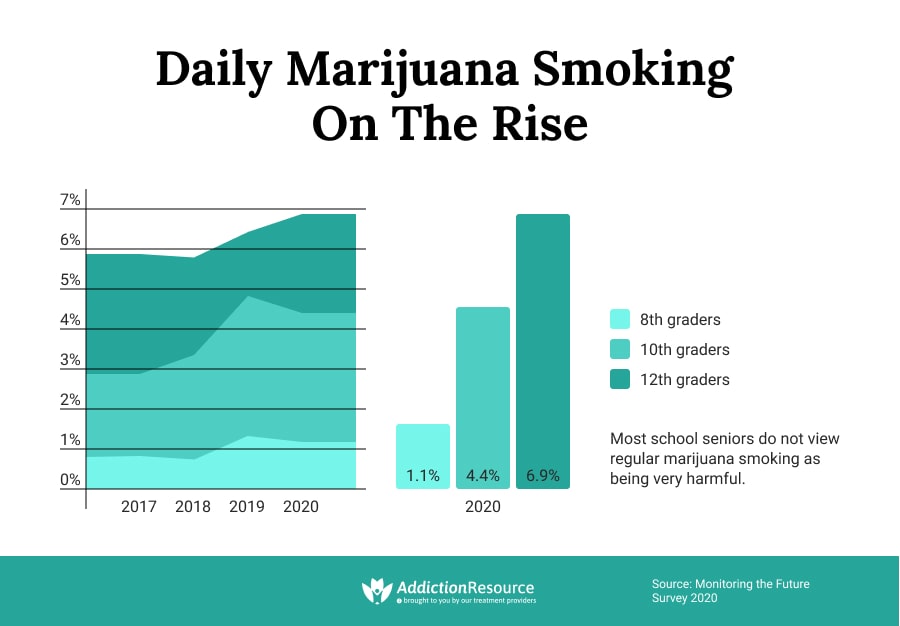
Teens, and some adults, also think that it is impossible to get addicted to marijuana, which leads to an increase in use. However, that is false. A study showed that about 30% of all marijuana users have a use disorder. It makes it even more dangerous to teens’ health that they may not have enough awareness of the risks before they start using the drug.
Spice/K2
Synthetic marijuana, also known as K2 or spice, is made of shredded parts of the marijuana plant mixed with other psychotropic substances. These substances are frequently similar to THC, only more dangerous to health because the illegal manufacturers change their chemical composition to avoid being caught by government agencies. Due to their marketing methods and widespread availability online, the use of these substances is becoming more and more common. It can have adverse effects, such as intense worry and anxiety, paranoia, and horrid hallucinations.
Prescription and OTC Drugs
Teens don’t usually have all the information that an adult would acquire throughout their life. Many teens think that since prescription medications are prescribed by a doctor, they’re safe for consumption for everyone. The same concept applies to OTC drugs. Since anyone can easily buy them without even needing a prescription, they “seem” safer than a hard drug on the streets. They seem to miss that all drugs are dangerous to mental and physical health if used without the advice of a physician. In 2014, over 5,700 teens admitted using prescription painkillers without a prescription.
However, painkillers aren’t the only OTC drugs teens have been reported abusing. Sedatives like Barbiturates, Benzodiazepines, zolpidem, OxyContin, Percocet, Vicodin, and Amphetamines are on the list too.
Teens tend to search for the uses of the drugs online and acquire them to use by themselves. One of the most common examples is the use of Adderall to boost academic performance, as it’s a drug that’s prescribed to ADHD patients to help them focus better.
These drugs seem harmless, but the incorrect dosage can have disastrous effects. Something as simple as a cough syrup can be dangerous in uncontrolled quantities as it contains Dextromethorphan, which can cause hallucinations. Not only that, it can even slow down breathing to the point that it causes accidental death. This alone shows how the drugs commonly found in our medicine cabinets can be life-threatening if misused.
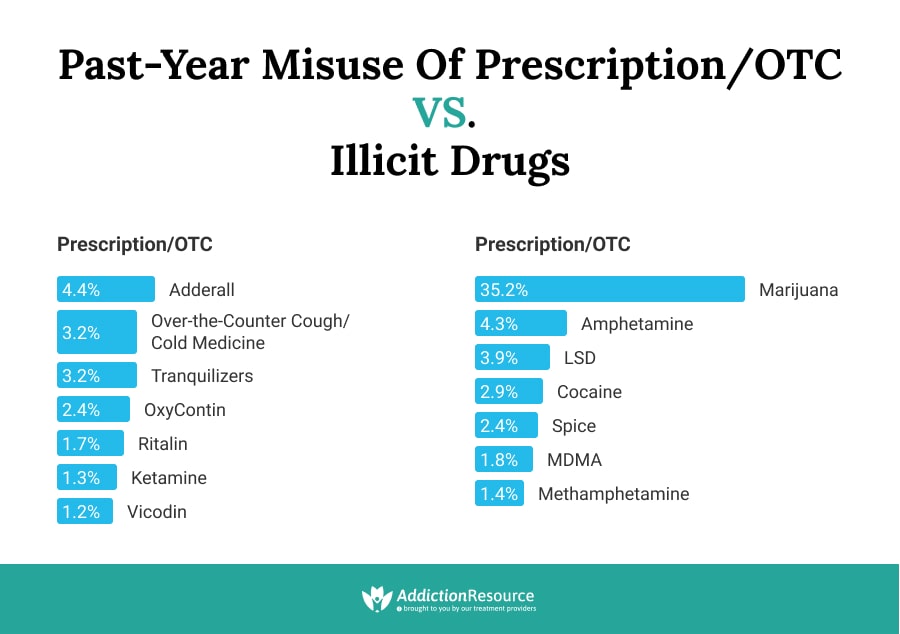
Vaping Among Teens
Vaping is often considered a “totally safe alternative to smoking.” People, especially young people, assume that vapes (or e-cigarettes or JUULs) only emit “water vapor,” which only looks like smoke but isn’t smoke at all. That isn’t true.

The aerosol that a vape is dangerous as it has Nicotine, Ultrafine particles that are harmful to the lungs if inhaled, diacetyl, an ingredient used in flavoring and has been linked to lung diseases, metals, and other cancer-causing chemicals. Making vaping far from “safe.”
2/3s of JUUL users don’t even know that there’s nicotine in it. What’s alarming is that in 2020, 3.02 million high school students reported regularly vaping.
Why Do Teens Experiment With Drugs?
There are many reasons teens can be interested in trying substances or alcohol. Human beings have an innate desire to experiment, and young people are prone to this. Boredom is a common reason. Many young people find it hard to keep themselves occupied doing something constructive or can’t stand being alone, making them prime candidates for teenage drug addiction. Addictive substances like alcohol and marijuana fill the emptiness they can feel. They give the teens something to do and help them interact with like-minded peers, forming what is perceived as a bond with a social group. It ends up being the foundation of why teens using drugs even begins to happen.
According to Statistics, Most Teens Using Drugs Decide to Try Drugs or Alcohol for the First Time Due To:
- Curiosity. The teen years are when young people are open to new experiences, and they may wonder what teens using drugs are like. They may have been inundated with warnings about the dangers of drug use, but at the same time, they’re also curious to know what being “high” is like. In many cases, this curiosity overrides any worries they might have about the drugs being as dangerous to health as the warnings make them seem. Teens’ brains are not fully developed in the area of the brain responsible for thinking ahead and understanding consequences, so they can often feel invincible and believe that bad things like teenage drug addiction won’t happen to them. Unfortunately, this is often not the case.
- Experimentation. Teens often want to try as many new things as possible, and drugs are, unfortunately, one of the most common experiments they attempt. Drinking alcohol is also a widespread activity teens engage in, easily leading to teenage alcoholism.
- Peer Pressure. Kids in their teen years often want to feel like they are part of the group or that they “fit in.” Sometimes they drink or try substances to fit in with a particular crowd or friend, or they may do it to appear “cool” or worldly to impress others. While some teens using drugs will not have to deal with any long-term consequences, others will become addicted.
- Stress. Between social pressures, extracurricular activities, and classes, teens have a lot on their plates. Add in the stress of attempting to decide on a college and major course of study, and some may find themselves overwhelmed. Sometimes, teens turn to drugs and alcohol to help them cope with the rigors of high school and the first few years of college. College drinking or using Adderall is especially common among young students.
- Emotional issues. It has been shown that teens who come from broken homes, those with dysfunctional home lives, mental illness, or mood disorders are more likely to use drugs and develop teenage alcoholism. This is usually because the drugs help numb their emotional pain and escape from negative feelings. Self-medication is a dangerous cycle that quickly leads to substance abuse and addiction in teens if the underlying issues are not dealt with quickly.
- Social Influence. Some adolescents see their parents drinking, smoking, and sometimes doing drugs. Sometimes they are urged by friends to have a drink or smoke cannabis. Gradually, they start to see drug use as something normal. The media also plays a very powerful role in this. Drug use, teenage alcoholism, and general alcohol use are glorified in films and music. A young person is led to believe this is something that is not only acceptable but indeed prestigious to do and act accordingly.
Possible Consequences Of Drug Addiction in Teens
As mentioned, teens and young adults are more likely to get addicted to drugs than adults because their brains aren’t fully formed. Drug abuse at a young age raises many medical and mental health concerns and impacts school performance adversely. It can also exacerbate underlying mental health issues. Teens suffering from depression are more likely to attempt suicide after abusing drugs.

Drug abuse can lead to severe weight loss and health risks stemming from inadequate nutrition as it makes its way to teenage drug addiction. When under the influence, a teen might engage in risky sexual behavior, such as casual unprotected sex.
Data from the National Survey on Drug Use and Health showed three times as many adults who abused marijuana before age 14 had a substance abuse issue or were addicted to it than those who had turned 18 before trying it.
How Can Drug Use Affect Teen’s Life?
Teenagers are extraordinarily vulnerable to substance use disorders because their brains are still developing, and some brain regions are less developed than others. For example, the area of the brain that processes responses to reward and pain matures early in childhood. But the prefrontal cortex – the brain region responsible for accurately assessing a situation, making sound decisions based on that assessment, and exercising control over our emotions and impulses – remains relatively undeveloped during our teen years. This area doesn’t fully mature until the mid-20s.
As a result, the teenage brain has been likened to a car with a fully functioning gas pedal (the reward system) but weak brakes (the prefrontal cortex). Physiologically, teens are as capable of pursuing pleasurable rewards and avoiding pain as an adult, but they still have serious limits on their ability to weigh risks accurately and to make sound decisions. It includes, of course, decisions about whether or not to use drugs.
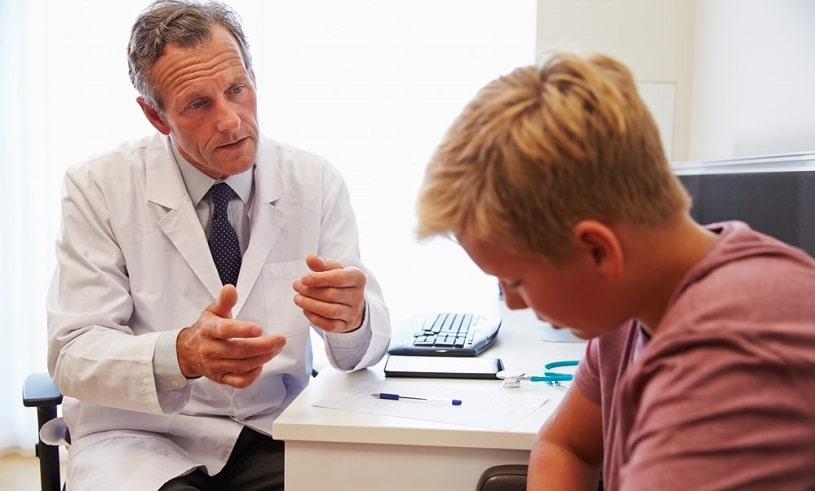
Our brains are “hard-wired” to pursue life-positive and healthful activities because our brains release a chemical called dopamine. Typically, the everyday rewards that result from normal teenage activities such as hanging out with friends, playing sports or games, and listening to music cause the moderate release of this chemical. The resulting dopamine increase thus reinforces behaviors that contribute to health, developing a sense of well-being, and building strong social bonds.
Drugs hijack this process. The “high” that drugs produce floods the teenage brain’s reward centers with much greater amounts of dopamine than usual. It creates a strong urge to repeat the experience. The immature brain, which is already trying to balance impulse and self-control without the fully developed tools, is thus more likely to take drugs again without paying any attention to possible negative consequences. If the drug experience is repeated, that reinforces the brain’s links between pleasure and drug-taking and strengthens the association. Soon, taking the drug takes on much greater importance than other rewards in the teen’s life.
This is the vicious cycle of addiction in teens. The drugs realign the teen’s priorities, but at the same time, they are chemically modifying the very brain regions needed to use proper judgment and exercise control.
Crimes And Accidents
According to the National Institute on Drug Abuse, car crashes are the leading cause of death among young people aged 16 to 19 years. Teenagers are less experienced and are more likely to underestimate dangerous situations than adults. They are also more likely to speed. When these factors and drug use are combined, the outcome can be tragic, and often is. Moreover, drugs and violence are often connected, and a teenager may commit crimes while under the influence.
Moreover, getting caught with drugs can damage a teen for life. Many schools are now permitted to conduct random drug tests and locker searches. If teens using drugs test positive or get caught with drugs on school grounds, the least that will happen to them is suspension from school. However, if the infractions are reported to the police, they can be charged with juvenile possession. If they sell drugs, the legal penalties are even harsher and can lead to significant fines or prison time.
Legal Problems
According to the Center for Behavioral Health Statistics and Quality report, almost half a million young adults signed up at a publicly funded treatment facility for alcoholism and teenage drug addiction or abuse in 2011. Most of them were referred by the criminal justice system – several hundred a day. The crime most commonly committed by teens using drugs is theft, but violent crimes are frequent, too. Teenage drug addiction can lead to truancy or even being expelled or dropping out of school because the teen has lost interest in studying.
Overdose
Opioid painkillers can be found at home, and more people die in the United States from opioid painkiller overdoses than from heroin and cocaine combined, including many teens. If a teen is buying drugs from an illegitimate online pharmacy, they have no way of knowing the actual dosage they have obtained. It makes addiction in teens and overdoses a horrifyingly real possibility. Drugs sold online may be stolen, diluted, mishandled, or contaminated. Overdose is a risk even if the online pharmacy is legal but located abroad.
Signs Of Drug Abuse Among Teenagers
Parents and teachers are the first line of defense regarding which teens are at risk of drug use and are already using. It’s not always easy to distinguish between drug abuse symptoms and typical teen angst, but there are some signs that a teen is using drugs.
The Signs Include:
- Poor academic performance
- Missing school and extracurricular activities
- Disappearances for significant periods without any explanation
- Rapid change of social circles or isolation
- Emotional instability or mood swings
- Problems with memory and concentration
- Periods of high and low energy
- Unexplained paranoid or anxious behavior
- Periods of drowsiness followed by periods of high energy
- Rapid changes in personality without any reason
- Changes in appetite
- Nausea, vomiting, constipation, and other stomach problems
- Troubled sleep
- Sudden unexplained weight loss or gain
Not all of the signs listed above mean drug addiction in teens. Some of them could indicate other issues. For instance, as a child becomes a teenager, they often change friends. They become interested in new things. Their way of dressing might change to match trends. All this notwithstanding, the more signs present, the more likely a teen is using drugs.
What to Do if One Suspects Teenage Drug Use
The first thing to do if suspecting a teen may be using drugs is to talk to them. Have an open discussion and express your concerns. Don’t go in with accusations because a teen will shut down and go defensive. Instead, let them know that one is offering help to deal with whatever they are going through.
If they admit to using drugs, it’s necessary to ask additional questions to determine how often, what drugs are being used, and how severe the drug abuse is. Parents may be able to stop the habit before it becomes a full-blown drug addiction in teens. Ask a teen why they decided to use drugs in the first place. If emotional or stress-related reasons are to blame, a parent can arrange for counseling or form a plan of action to prevent further drug abuse. If an addiction in teens is suspected, one will need to get proper treatment for a child immediately.
If a teen denies using drugs, but parents believe they are being untruthful, there are ways one can determine whether teenagers have been using drugs. At-home drug kits are available to test for many drugs, such as marijuana.

Additional drug tests are offered by the doctor or another medical professional. If it is determined that drug abuse has been going on, approach a teen again and express all concerns. Try to present this case in a loving, non-accusatory manner to ensure one gets the best response. Treatment is far more effective when the person seeking recovery is a willing participant.
Become Actively Involved in Drug Education and Prevention
Learn as much as possible about drugs, their effect on the mind and body, and their perils, and then communicate that to a teen openly. Find accurate, science-based information about drugs (as opposed to “scare stories”) and make it available.
Remember the power of “peer pressure” and that teens will be encouraged to take drugs by their friends. And teenagers trust their friends and seek their approval.
So sit down with a teen and have a discussion that tells them it’s OK to say no, and help them develop strategies for doing so. Many government websites offer such techniques, such as the Ways to say “no” to drugs site from girlshealth.gov and the 6 Tactful Tips for Resisting Peer Pressure To Use Drugs and Alcohol site from the National Institute on Drug Abuse for Teens.
How To Prevent Substance Abuse In Teens?
Prevention is better than cure. Parents must be open to talking to their children about the dangers of drug addiction in teens. Ensuring teenagers have all the information about the risks of substance abuse in teens will equip them to say no when the need arises.
It is also essential that the parents know the signs of their child using drugs and teenage alcoholism. Things like withdrawal from social settings heightened aggression and other physical and psychological symptoms, so if the abuse begins, it can be stopped immediately and get treatment. Having clear, open communication is the first step in treatment.
Here’s How to Talk to a Child About Drug Abuse:
Do
- Regularly explain to a child the dangers and possible side effects of substance abuse in teens
- Answer the questions a child asks; listen to their ideas and stories
- Point out real-life examples of drug addiction in teens if they have a moral outcome and teach not to abuse drugs and alcohol
- Help children to realize that parents are on their side and they can count on them if teens have drug or alcohol issues
- Let them know they can contact a parent or trusted grown-up if they need help
Don't
- Assume a child already knows about the dangers of substance abuse in teens from school, books, or mass media
- Talk without listening or criticize the thoughts of a child without argumentation
- Lie or hide the information on the drug addiction in teens and alcohol abuse, including the family stories
- Accuse a child of using illicit substances without proof and reason
- Punish the children. find a qualified treatment provider instead
Treatment for Adolescent Drug Abuse
If a teen is already addicted to drugs, it’s integral that the parents help immediately. Several rehabilitation centers available that a parent can contact throughout the US offer many treatment approaches to create the perfect treatment plan for each teen.
At the rehab for teens, the patient is provided information, care, and attention so they can be safe during the detox period and successfully get the drugs out of their system and return to everyday life.
The rehab for teens will also have programs for aftercare. They can contact a therapist who will ensure that the teen is supported throughout all recovery phases and has all the information and support they need, so they don’t fall into the trap of drugs again.
With the right help, things can be easier than they seem. All that is needed to get on the right track to recovery is to take the first step. Contact us and get the help that is needed right now.
Hope Without Commitment
Find the best treatment options. Call our free and confidential helpline
Most private insurances accepted
Page Sources
- Substance Abuse and Mental Health Services Administration. National Survey of Substance Abuse Treatment Services (N-SSATS). Data on Substance Abuse Treatment Facilities. 2020 https://www.samhsa.gov/data/sites/default/files/reports/rpt35313/2020_NSSATS_FINAL.pdf
- National Institute on Drug Abuse. Monitoring the Future Study: Trends in Prevalence of Various Drugs. 2020 https://www.drugabuse.gov/drug-topics/trends-statistics/monitoring-future/monitoring-future-study-trends-in-prevalence-various-drugs
- National Institute on Drug Abuse. Drug Overdoses in Youth. 2019. https://teens.drugabuse.gov/drug-facts/drug-overdoses-youth
- Johnston, L. D., Miech, R. A., O'Malley, P. M., Bachman, J. G., Schulenberg, J. E., & Patrick, M. E. (2021). Monitoring the Future National Survey Results on Drug Use, 1975-2020: Overview, Key Findings on Adolescent Drug Use. Institute for Social Research. https://files.eric.ed.gov/fulltext/ED611736.pdf
- Hasin, D. S., Saha, T. D., Kerridge, B. T., Goldstein, R. B., Chou, S. P., Zhang, H., Jung, J., Pickering, R. P., Ruan, W. J., Smith, S. M., Huang, B., & Grant, B. F. (2015). Prevalence of Marijuana Use Disorders in the United States Between 2001-2002 and 2012-2013. JAMA Psychiatry, 72(12), 1235–1242. https://pubmed.ncbi.nlm.nih.gov/26502112/
- Abuse, S., & Administration, M. H. S. (2014). National survey on drug use and health. https://www.samhsa.gov/data/sites/default/files/NSDUH-FRR1-2014/NSDUH-FRR1-2014.pdf
- National Institute on Drug Abuse. Over-the-Counter Medicines. https://www.drugabuse.gov/publications/drugfacts/over-counter-medicines
- Centers for Disease Control and Prevention. Quick Facts on the Risks of E-cigarettes for Kids, Teens, and Young Adults https://www.cdc.gov/tobacco/basic_information/e-cigarettes/Quick-Facts-on-the-Risks-of-E-cigarettes-for-Kids-Teens-and-Young-Adults.html
- Centers for Disease Control and Prevention. E-cigarette Use Among Middle and High School Students — United States. 2020. https://www.cdc.gov/mmwr/volumes/69/wr/mm6937e1.htm
- National Institute on Drug Abuse. Drugged Driving DrugFacts. https://www.drugabuse.gov/publications/drugfacts/drugged-driving
- Substance Abuse and Mental Health Services Administration. https://www.samhsa.gov/

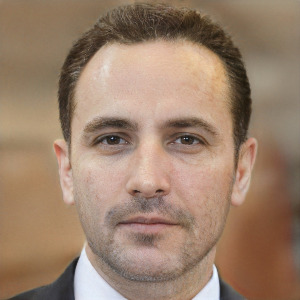 Authored by
Authored by  Reviewed by
Reviewed by